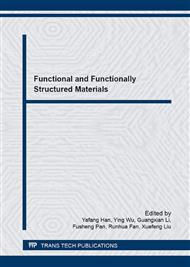[1]
Singhal S C. Advances in solid oxide fuel cell technology[J]. Solid state ionics, 2000, 135(1): 305-313.
DOI: 10.1016/s0167-2738(00)00452-5
Google Scholar
[2]
Ivers-Tiffee E, Weber A, Herbstritt D. Materials and technologies for SOFC-components[J]. Journal of the European Ceramic Society, 2001, 21(10): 1805-1811.
DOI: 10.1016/s0955-2219(01)00120-0
Google Scholar
[3]
Zhang C, Liao H L, Li W Y, et al. Characterization of YSZ solid oxide fuel cells electrolyte deposited by atmospheric plasma spraying and low pressure plasma spraying[J]. Journal of thermal spray technology, 2006, 15(4): 598-603.
DOI: 10.1361/105996306x146965
Google Scholar
[4]
Steele B C H, Heinzel A. Materials for fuel-cell technologies[J]. Nature, 2001, 414(6861): 345-352.
DOI: 10.1038/35104620
Google Scholar
[5]
Majhi S M, Behura S K, Bhattacharjee S, et al. Anode supported solid oxide fuel cells (SOFC) by electrophoretic deposition[J]. International journal of hydrogen energy, 2011, 36(22): 14930-14935.
DOI: 10.1016/j.ijhydene.2011.02.100
Google Scholar
[6]
Liu Y, Compson C, Liu M. Nanostructured and functionally graded cathodes for intermediate temperature solid oxide fuel cells[J]. Journal of Power Sources, 2004, 138(1): 194-198.
DOI: 10.1016/j.jpowsour.2004.06.035
Google Scholar
[7]
Cheng J, Bao W, Han C, et al. A novel electrolyte for intermediate solid oxide fuel cells[J]. Journal of Power Sources, 2010, 195(7): 1849-1853.
DOI: 10.1016/j.jpowsour.2009.10.017
Google Scholar
[8]
Sun W, Huang X, Lü Z, et al. NiO+ YSZ anode substrate for screen-printing fabrication of YSZ electrolyte film in solid oxide fuel cell[J]. Journal of Physics and Chemistry of Solids, 2009, 70(1): 164-168.
DOI: 10.1016/j.jpcs.2008.09.019
Google Scholar
[9]
Gannon P, Sofie S, Deibert M, et al. Thin film YSZ coatings on functionally graded freeze cast NiO/YSZ SOFC anode supports[J]. Journal of applied electrochemistry, 2009, 39(4): 497-502.
DOI: 10.1007/s10800-008-9682-4
Google Scholar
[10]
J. Kim, Y.S. Lin. Sol—gel synthesisand characterization ofyttria stabilized zirconia membranes[J]. Journalof MembranceSciene, 1 998, 139: 75. 83.
Google Scholar
[11]
J, Ding,J. Liu. An anode—supposedsolid oxide fuel cell withspray—coatedyttria·stabilized zirconia(YSZ)electrolyte film[J]. SolidState Ionics, 2008, 179: 1246. 1249.
DOI: 10.1016/j.ssi.2008.01.094
Google Scholar
[12]
Yoo Y S, Choi M H, Lee T H. Production method for a support type coating membrane using tape casting: U.S. Patent Application 14/345, 880[P], 2012-9-20.
Google Scholar
[13]
Han M F, Tang X L, Yin H Y et al. Journal of Power Source[J], 2007, 165: 757.
Google Scholar


